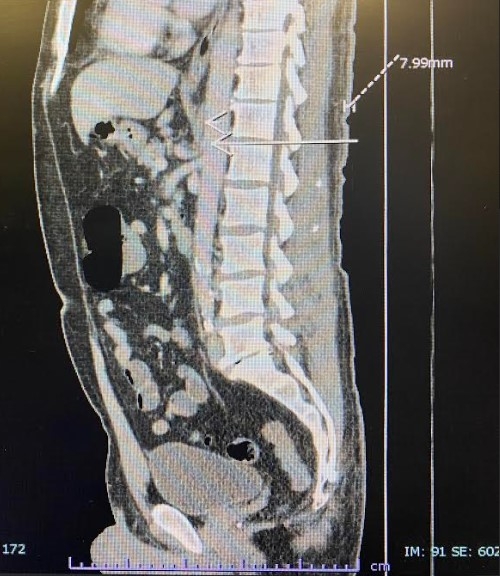Monday Poster Session
Category: Stomach and Spleen
P4249 - Starved by Anatomy: The Overlooked Culprit Behind Chronic Epigastric Pain
Monday, October 27, 2025
10:30 AM - 4:00 PM PDT
Location: Exhibit Hall

Wael T. Mohamed, MD (he/him/his)
University of Kansas School of Medicine
Wichita, KS
Presenting Author(s)
Wael T. Mohamed, MD1, Mohamed Omar, MD1, William J.. Salyers, MD, MPH2, Kyle Rowe, MD1, Nathan Tofteland, MD1
1University of Kansas School of Medicine, Wichita, KS; 2University of Kansas School of Medicine - Wichita, Wichita, KS
Introduction: Median arcuate ligament syndrome (MALS), also known as celiac artery compression syndrome, is a rare vascular disorder caused by external compression of the celiac artery by the median arcuate ligament of the diaphragm. It predominantly affects middle-aged women with slender body habitus and is frequently underdiagnosed due to its nonspecific gastrointestinal symptoms.
Case Description/
Methods: We report the case of a 45-year-old male with a history of rheumatoid arthritis who presented with a 5-week history of progressive, severe epigastric pain and a 30-pound unintentional weight loss. Initial investigations including upper endoscopy and laboratory studies were unrevealing. CT angiography demonstrated significant celiac artery stenosis with characteristic features of MALS, confirmed by Doppler ultrasonography showing elevated expiratory-phase velocities. Given the patient’s symptom burden and imaging findings, he underwent successful median arcuate ligament release surgery, resulting in marked clinical improvement.
MALS remains a diagnosis of exclusion, typically confirmed through a combination of imaging modalities. Its pathophysiology may involve both ischemic and neuropathic mechanisms. Surgical decompression with celiac ganglionectomy remains the definitive treatment and is associated with favorable outcomes when performed in appropriately selected patients.
Discussion: This case highlights the importance of maintaining a high index of suspicion for MALS in patients presenting with chronic, unexplained abdominal pain and significant weight loss. Early diagnosis and prompt surgical management can lead to significant symptom resolution and improved quality of life.

Figure: Extensive atherosclerosis of the abdominal aorta that was premature for this patient’s age. There was marked narrowing and mass effect on the celiac axis with a resulting sixty to seventy percent stenosis noted.
Disclosures:
Wael Mohamed indicated no relevant financial relationships.
Mohamed Omar indicated no relevant financial relationships.
William Salyers indicated no relevant financial relationships.
Kyle Rowe indicated no relevant financial relationships.
Nathan Tofteland indicated no relevant financial relationships.
Wael T. Mohamed, MD1, Mohamed Omar, MD1, William J.. Salyers, MD, MPH2, Kyle Rowe, MD1, Nathan Tofteland, MD1. P4249 - Starved by Anatomy: The Overlooked Culprit Behind Chronic Epigastric Pain, ACG 2025 Annual Scientific Meeting Abstracts. Phoenix, AZ: American College of Gastroenterology.
1University of Kansas School of Medicine, Wichita, KS; 2University of Kansas School of Medicine - Wichita, Wichita, KS
Introduction: Median arcuate ligament syndrome (MALS), also known as celiac artery compression syndrome, is a rare vascular disorder caused by external compression of the celiac artery by the median arcuate ligament of the diaphragm. It predominantly affects middle-aged women with slender body habitus and is frequently underdiagnosed due to its nonspecific gastrointestinal symptoms.
Case Description/
Methods: We report the case of a 45-year-old male with a history of rheumatoid arthritis who presented with a 5-week history of progressive, severe epigastric pain and a 30-pound unintentional weight loss. Initial investigations including upper endoscopy and laboratory studies were unrevealing. CT angiography demonstrated significant celiac artery stenosis with characteristic features of MALS, confirmed by Doppler ultrasonography showing elevated expiratory-phase velocities. Given the patient’s symptom burden and imaging findings, he underwent successful median arcuate ligament release surgery, resulting in marked clinical improvement.
MALS remains a diagnosis of exclusion, typically confirmed through a combination of imaging modalities. Its pathophysiology may involve both ischemic and neuropathic mechanisms. Surgical decompression with celiac ganglionectomy remains the definitive treatment and is associated with favorable outcomes when performed in appropriately selected patients.
Discussion: This case highlights the importance of maintaining a high index of suspicion for MALS in patients presenting with chronic, unexplained abdominal pain and significant weight loss. Early diagnosis and prompt surgical management can lead to significant symptom resolution and improved quality of life.

Figure: Extensive atherosclerosis of the abdominal aorta that was premature for this patient’s age. There was marked narrowing and mass effect on the celiac axis with a resulting sixty to seventy percent stenosis noted.
Disclosures:
Wael Mohamed indicated no relevant financial relationships.
Mohamed Omar indicated no relevant financial relationships.
William Salyers indicated no relevant financial relationships.
Kyle Rowe indicated no relevant financial relationships.
Nathan Tofteland indicated no relevant financial relationships.
Wael T. Mohamed, MD1, Mohamed Omar, MD1, William J.. Salyers, MD, MPH2, Kyle Rowe, MD1, Nathan Tofteland, MD1. P4249 - Starved by Anatomy: The Overlooked Culprit Behind Chronic Epigastric Pain, ACG 2025 Annual Scientific Meeting Abstracts. Phoenix, AZ: American College of Gastroenterology.
